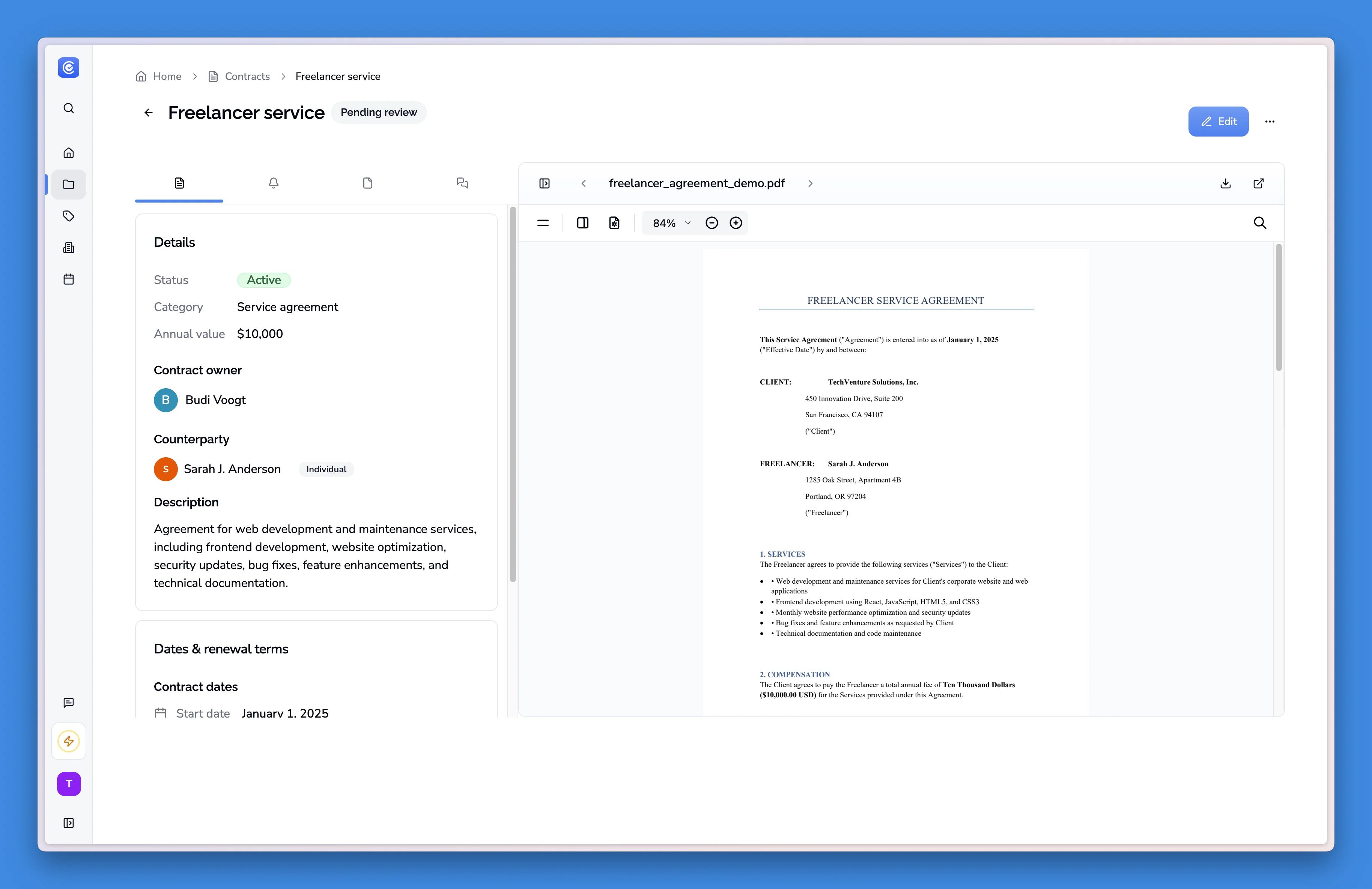AI contract management: How it works and why small businesses need it

Managing contracts manually creates risk. Missed renewal dates cost money. Lost agreements create liability. Manual tracking across departments creates chaos. For small businesses, in-house counsel, and operations teams, these problems compound quickly.
AI contract management solves this by automating the tedious parts—extracting data, tracking deadlines, organizing documents, and surfacing risks before they become problems.

What is AI contract management?
AI contract management uses natural language processing and machine learning to read, understand, and organize contracts automatically. Instead of manually reviewing every agreement, the technology extracts key information—parties, dates, payment terms, renewal clauses, obligations—and makes it searchable and actionable.
The core technologies work in layers:
Natural Language Processing (NLP) reads contract text the way a human would, understanding context and meaning. It identifies what matters: "This agreement automatically renews on January 15, 2026 unless either party provides 90 days written notice."
Machine learning improves over time. The more contracts the system processes, the better it gets at recognizing patterns, flagging unusual terms, and categorizing agreements accurately.
Data extraction pulls specific information into structured fields. Instead of reading through a 40-page vendor agreement to find the termination clause, AI contract analysis surfaces it instantly.
This isn't theoretical. Small businesses use this technology daily to manage hundreds or thousands of contracts without adding headcount.
Benefits of AI contract management
Speed and efficiency
Manual contract review takes hours. AI does it in seconds.
A procurement manager reviewing a 30-page vendor agreement might spend 45 minutes finding key terms, entering data into a spreadsheet, and setting calendar reminders. AI extracts all relevant data—parties, effective dates, payment schedules, renewal terms—in under a minute.
For teams managing 50+ contracts, this matters. Three hours of weekly contract administration drops to 15 minutes. That time goes back to strategic work: negotiating better terms, analyzing vendor performance, or managing relationships.
Contract tracking systems also eliminate the "Where is the Johnson agreement?" problem. Every contract lives in one searchable repository. Any team member finds what they need in seconds, not hours.

Risk mitigation
The most expensive contract failures happen after signing. A missed 90-day termination notice means another year of unwanted service. An overlooked auto-renewal clause costs thousands in unexpected charges.
AI prevents this by monitoring deadlines continuously. Expiration reminder systems track every deadline in every contract—renewal dates, notice periods, payment schedules, compliance requirements. Alerts go out automatically, with enough lead time to act.
This matters for in-house counsel and finance teams managing regulatory compliance. When audit time arrives, pulling every contract with a specific clause takes minutes, not days. Proving compliance becomes straightforward.
Risk flagging works beyond deadlines. AI identifies unusual terms, conflicting obligations, or clauses that deviate from standard playbooks. For small businesses without dedicated legal teams, this creates a safety net.
Cost savings
AI contract management pays for itself quickly, often on the first prevented auto-renewal.
Consider a typical scenario: A growing company signs a software contract with automatic annual renewal. The service costs $15,000 per year. After 18 months, the company stops using it but forgets about the contract. Without a 90-day termination notice, renewal happens automatically. That's $15,000 gone—more than most small businesses spend on contract management software all year.
Finance teams use AI contract management to track payment terms across all vendor agreements. This visibility enables better cash flow planning and catches billing errors before payment goes out.
The cost savings extend to operations. Centralizing contracts eliminates duplicate vendor agreements (the marketing team and operations team unknowingly signing separate contracts with the same provider) and enables volume negotiation when renewals approach.
What AI contract management does
The practical capabilities matter more than the technology behind them.
Metadata extraction reads every contract and pulls out the information you need: contract name, counterparty, start date, end date, renewal terms, payment amounts, notice periods, and governing law. This data becomes searchable. Finding "all contracts expiring in Q1 2026" takes seconds.
Deadline tracking monitors every important date. Not just end dates—notice periods, milestone dates, payment schedules, compliance deadlines. Calendar integration puts these deadlines where teams already work, making them impossible to miss.
Risk assessment flags unusual or problematic terms. A liability cap lower than industry standard. An auto-renewal clause without a termination window. A payment term buried in section 12.4 that contradicts the payment schedule in section 3.
Document organization creates a single source of truth. Every contract, every amendment, every related document lives in a centralized repository. Version control is automatic. Finding the current version of any agreement is instant.
Reporting and visibility surfaces patterns across contracts. Expiration reporting shows which renewals are coming up across all departments. Spend analysis reveals which vendors receive the most money. Obligation tracking ensures nothing falls through the cracks.

Who benefits from AI contract management
Different teams use the same system for different purposes.
Management teams gain visibility across the organization. Instead of asking five different people about contract status, management sees everything in one dashboard. Strategic planning improves when renewal dates and contract obligations are clear months in advance.
Finance teams track payment obligations, monitor spending by vendor, and forecast costs accurately. When budget season arrives, knowing exactly which contracts renew when and for how much removes guesswork. Finance also catches billing errors by comparing invoices against contract terms automatically.
Procurement teams manage vendor relationships better when contract terms are accessible. Purchasing teams negotiate from strength when they know exactly what terms other vendors offered. Volume discounts become possible when similar contracts are grouped together.
Legal teams and in-house counsel focus on high-value work instead of contract administration. Legal teams still review complex agreements, but routine contracts flow through automatically. Compliance reporting that once took days now takes minutes. Finding every contract with a specific clause happens with a search, not a reading marathon.
Operations teams coordinate across departments. When operations knows which software licenses are expiring, they prevent service interruptions. When they track maintenance agreements, equipment stays functional. Contract management becomes operational management.
Small businesses and freelancers benefit most. Without dedicated contract management staff, AI levels the playing field. A solo consultant with 30 client agreements manages them as effectively as a team of five would manually.
Limitations of AI in contract management
AI contract management is powerful but not magic. Understanding limitations prevents disappointment.
Legal judgment remains essential. AI identifies unusual terms but can't determine if they're problematic in your specific context. A jurisdiction clause might be standard in one industry and problematic in another. In-house counsel or legal review still matters for complex, high-value, or unusual agreements.
Context understanding has boundaries. AI excels at recognizing patterns and extracting data from standard contracts. Custom agreements with unusual structures or highly technical language may require human review to ensure accuracy. The system flags what looks unusual, but humans decide if it matters.
Playbook guardrails improve results. AI works best when you define standards first. What constitutes a standard payment term? Which clauses always require legal review? Clear policies make AI more effective.
Data privacy requires attention. Contract content is sensitive. Systems must handle data securely, with encryption and access controls. For businesses in regulated industries, ensuring the AI contract management platform meets compliance standards (SOC 2, GDPR) is non-negotiable.
AI augments human expertise, it doesn't replace it. The goal is letting humans focus on judgment while AI handles repetition.
How Contracko handles AI contract management
We built Contracko specifically for small businesses, in-house counsel, and teams managing contracts without dedicated contract management staff.
Add contracts with AI—upload an agreement, and the system extracts parties, dates, and obligations automatically. Contracts become organized immediately, not after hours of data entry.
The platform emphasizes what happens after signing. While many tools focus on contract creation and negotiation, we focus on lifecycle management—tracking deadlines, preventing missed renewals, and ensuring obligations are met. Most customers save more on their first cancelled auto-renewal than they spend on Contracko all year.
Every plan includes unlimited users. No per-seat pricing means your entire team—legal, finance, procurement, management, operations—accesses the same information without budget concerns. Security uses enterprise-grade encryption and is GDPR compliant.
Setup takes hours, not weeks. Most teams are up and running the same day.
Get started
See how AI contract management works for your team. Contracko offers a 7-day free trial with full access—no credit card required. Start tracking your first contract now.
Get started with Contracko
Take the hassle out of contract and subscription management. Contracko empowers you to stay organized, on time, and in control. Start simplifying today.